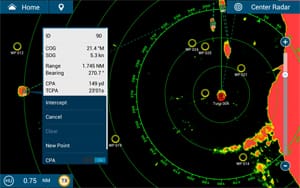Marine electronics companies continue to make impressive technical strides in a variety of areas. One of these is radar. The marine radar units currently available to voyagers have impressive capabilities — in particular, their collision avoidance options that make voyaging easier and safer.
The recent World War II-era movie Greyhound starring Tom Hanks depicts the Battle of the Atlantic and has radar as a major element. We see the crew of Hanks’ destroyer using radar to detect enemy submarines. The radar of that era was good for detection and ranging, but in order to know anything about how a particular vessel was moving relative to your own, you needed to break out the grease pencil and plotting board to manually draw in the bearings and vectors. The filmmakers of Greyhound actually give us a quick example of this process, and we see a crewmember calculating a course to intercept by drawing grease pencil lines on a erasable plotting board.
For commercial mariners in the immediate post-WWII era, radar sets were developed with special plotting screens that overlaid the radar display. Plots could be done on that overlay using a grease pencil, and the plot could be erased as the situation changed so the new situation could be plotted. These commercial mariners drew their plots to calculate the closest point of approach (CPA) and time to closest point of approach (TCPA). In busy shipping lanes with many contacts on the screen, this type of plotting could get intense. A former watch officer who worked aboard the liner SS United States once told me that he used up an entire grease pencil on a particularly busy watch through the English Channel.
Even without a plotting overlay, it is still possible to plot radar contacts by using a rapid radar plotting sheet. This is a technique we regularly taught students in Ocean Navigator’s School of Seamanship seminars, both ashore and on board schooners like Westward and Ocean Star. In this method, you use a radar’s variable range marker (VRM) and electronic bearing line (EBL) to get information on a contact. You plot that range and bearing on your paper plotting sheet. Then, after six minutes has elapsed — making sure your vessel is on the same heading as when you took the earlier measurements — you get a second set of range and bearing info. After plotting these, you have an initial sense of the contact’s likely CPA and TCPA if both you and the contact hold your courses. This technique works well, although with multiple contacts it makes for a busy watch.
For commercial mariners using big ship radars, this process was automated with the introduction of radars with an automatic radar plotting aid (ARPA) capability. Early ARPAs were add-on modules that could electronically track a contact and calculate the CPA and TCPA. For a long time, this capability was reserved to big ship radars. Then, marine electronics companies introduced a greatly reduced ARPA capability that could track one or two contacts. This was dubbed “mini-ARPA” (MARPA).
Now, these firms have released units that provide recreational mariners with an expanded ARPA capability. The Furuno NXT radars, for example, have the ability to track up to 100 contacts and provide users with info on their relative movement.
Senior product manager Eric Kunz at Furuno put it this way in an email: “It is the true automatic acquisition ARPA capability that we bring down from our commercial radar ARPA systems. True ARPA is in all of our DRS radars that are compatible with TZT2/TZT3. The NXT radars can be set to acquire … any target that breaks the Doppler shift threshold. … This makes using the NXT radar a truly automatic process, and the operator doesn’t have to touch the screen at all to track any target detected by the radar that is a moving navigation threat.”
The NXT radars also have another interesting capability that Kunz alludes to above. Furuno calls it the “Target Analyzer” function. Since the NXT radars are Doppler-based radars, Furuno makes use of the Doppler shift of the returned echoes to calculate whether the contact is stationary, moving away from you or heading toward you. With the Target Analyzer function turned on, stationary and receding contacts are displayed in green while approaching contacts show as red. This improves your situational awareness by giving you a quick visual idea of which radar contacts on your screen are the most important to keep an eye on in order to avoid a close-quarters situation.
Some voyagers might say that this type of capability in a radar or, indeed, even a radar unit itself is not needed with today’s widespread use of automatic identification systems (AIS) and GPS-driven electronic plotters. While AIS does provide an excellent way to track other vessels, it also relies on those other vessels being equipped with an AIS, having it turned on and it working properly. A great advantage of radar is that you are in control of the information you are receiving regarding other vessels; you’re not relying on them to provide you with information. In addition, radar can be used to assist in navigation.
Modern radar units are amazing, and their capabilities would likely have greatly impressed the grease pencil-equipped radar users of many past bridge watches.

